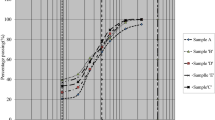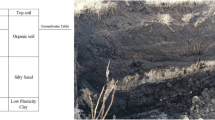Abstract
The undisturbed sampling from natural carbonate gravel-bearing subgrade soil for shear strength tests is a challenging process, or in-situ tests are costly and require time. In addition, mechanical properties of soils, provided through laboratory testing are not commonly in good harmony with the in-situ characteristics of the same soil. For these reasons, back-calculation of the in-situ shear strength parameters and Poisson’s ratio of a 2 m thick subgrade soil was addressed in this study. In this context, a total of nine lightweight deflectometer tests (LWDTs) were performed. Back analyses were performed considering the in-situ measured settlement under the plate with the aid of 3D numerical models based on elastic theory. The dynamic deformation moduli derived from LWDT were used as input for the numerical models. The soil physical properties were obtained from laboratory tests. The subgrade soil was characterized by the Mohr–Coulomb failure criterion. Initially, a site-specific Poisson’s ratio was back-calculated. Afterward, the finite element models were operated for trial sets of internal friction angle and cohesion values until the amount of settlement from iterative numerical solution converges to the one derived from the LWDT. Hence, the test results were simulated with 0.001 mm precision. Additionally, settlement under the plate was calculated empirically considering the elastic, half-space medium. The empirical settlement values were well correlated with the test results. As a result of this study, it is recommended to investigate correlations between the LWDT results and physical properties to accurately evaluate the performance of numerical simulation models.









Similar content being viewed by others
Data Availability
All data generated or analysed during this study are included in this published article.
References
Adam C, Adam D (2003) Modeling of the dynamic load plate test with the light falling weight device. Asian J Civ Eng (Build Housing) 2(4):73–89
Adam C, Adam D, Kopf F, Paulmich I (2009) Computational validation of static and dynamic plate load testing. Acta Geotech. https://doi.org/10.1007/s11440-008-0081-0
Adam D, Adam C, Kopf F (2004) The dynamic load plate test with the light falling weight device: Experimental and numerical investigations. In: Proceedings of 11th International Conference on Soil Dynamics and Earthquake Engineering (11th ICSDEE), Berkeley, University of California, p 649–654
Ahmed AT, Khalid HA (2011) Back calculation models to evaluate light falling weight deflectometer moduli of road foundation layer made with bottom ash waste. Transp Res Rec. https://doi.org/10.3141/2227-07
Allen T (2021) Geotechnical design manual. https://wsdot.wa.gov/engineering-standards/all-manuals-and-standards/manuals/geotechnical-design-manual. Accessed 23 November 2021
Alshibli KA, Abu-Farsakh M, Seyman E (2005) Laboratory evaluation of the geogauge and light failing weight deflectometer as construction control tools. J Mater Civ Eng. https://doi.org/10.1061/(ASCE)0899-1561(2005)17:5(560)
Asli C, Feng ZQ, Porcher G, Rincent JJ (2012) Back-calculation of elastic modulus of soil and subgrade from portable falling weight deflectometer measurements. Eng Struct. https://doi.org/10.1016/j.engstruct.2011.10.011
ASTM D2487–17e1 (2017) Standard practice for classification of soils for engineering purposes (Unified Soil Classification System), ASTM International, West Conshohocken, PA
ASTM D4254–16 (2016) Standard test methods for minimum index density and unit weight of soils and calculation of relative density. ASTM International, West Conshohocken, PA
ASTM D6913/D6913M-17 (2017) Standard test methods for particle-size distribution (gradation) of soils using sieve analysis. ASTM International, West Conshohocken, PA
ASTM E2583–07 (2015) standard test method for measuring deflections with a light weight deflectometer (LWD). ASTM International, West Conshohocken, PA
Brandl H, Adam D, Kopf F, Niederbrucker R (2003) The dynamic load plate test with the light falling weight device (in German). Bundesministerium für Verkehr, Innovation und Technologie Straßenforschung, Wien, 528
Day RA, Hight DW, Potts DM (2001) Coupled pore pressure and stability analysis of embankment dam construction. In: Khalili N (ed) Valliappan S. Computational mechanics-new frontiers for the new millennium, Elsevier, pp 339–344
Ji R, Siddiki N, Nantung T, Kim D (2014) Evaluation of resilient modulus of subgrade and base materials in Indiana and its implementation in MEPDG. Sci World J. https://doi.org/10.1155/2014/372838
Kaya O (1981) Miocene reference section for the coastal parts of West Anatolia. Newsl Stratigr 10:164–191
Kim JR, Kang HB, Kim D, Park DS, Kim WJ (2007) Evaluation of in situ modulus of compacted subgrades using portable falling weight deflectometer and plate-bearing load test. J Mater Civ Eng. https://doi.org/10.1061/(ASCE)0899-1561(2007)19:6(492)
Klvač R, Vrána P, Jiroušek R (2010) Possibilities of using the portable falling weight deflectometer to measure the bearing capacity and compaction of forest soils. J For Sci. https://doi.org/10.17221/71/2009-JFS
Koloski JW, Schwarz SD, Tubbs DW (1989) Geotechnical properties of geologic materials. Washington Div Geol Earth Res Bull 78:19–24
Kopf F, Adam D, Paulmichl I (2005) Investigation of the dynamic plate load test with light-weight deflectometer using the boundary element method. https://insitutek.com/wp-content/uploads/2011/11/Investigation_of_ZFG_2000_using_Boundary_Element_Method.pdf. Accessed 23 November 2021
Mashinsky EI (2003) Differences between static and dynamic elastic moduli of rocks: physical causes. Geol Geofiz 44(9):953–959
Miller PK, Rinehart RV, Mooney MA (2007) Measurement of soil stress and strain using in-ground instrumentation. In: Proceedings of the ASCE Geoinstitute GeoDenver Conference, Denver, p 10
Müller C (2003) The light falling weight device. A new and innovative compaction testing method. Theory and practice. Dissertation, Vienna University of Technology
Nazzal MD, Murad YA, Khalid A, Mohammad L (2007) Evaluating the light falling weight deflectometer device for in situ measurement of elastic modulus of pavement layers. Trans Res Rec. https://doi.org/10.3141/2016-02
Oh JH, Fernando EG, Lee SI, Holzschuher C (2012) Correlation of asphalt concrete layer moduli determined from laboratory and nondestructive field tests. J Transp Eng. https://doi.org/10.1061/(ASCE)TE.1943-5436.0000316
Paulmichl I, Kopf F, Adam C (2005) Numerical simulation of the dynamic load plate test with the light falling weight device by means of the boundary element method. In: Soize C, Schueller GI (eds) Structural dynamics—EURODYN2005, Proceedings of 6th European conference on structural dynamics, Milpress, Rotterdam, p 1285–1290
Pospisil K, Zednik P, Stryk J (2014) Relationship between deformation moduli obtained using light falling weight deflectometer and static plate test on various types of soil. Balt J Road Bridge Eng. https://doi.org/10.3846/bjrbe.2014.31
Poulos HG, Davis EH (1974) Elastic solutions for soil and rock mechanics. Wiley, New York
Road and Transport Research Association, Working Group for Foundation and Soils (2003) Dynamic plate-load testing with the aid of the light drop-weight tester, technical test code for soil and rock mechanics in road construction. Report No TP BF-StB Part B8.3, Cologne, Germany
Rocscience (2012) Settle3 Version 2.016
Rocscience (2021) RS3 v.4.020
Roksana K, Nowrin T, Hossain S (2019) A Detailed Overview of Light Weight Deflectometer (LWD). In: Proceedings of International Conference on Planning, Architecture and Civil Engineering, Rajshahi University of Engineering and Technology, Bangladesh
Schleicher F (1926) Zur theorie des Baugrundes. Bauingenieur 48:931–935
Sebaaly BE, Mamlouk MS, Davies TG (1986) Dynamic Analysis of Falling Weight Deflectometer Data. In: Transportation Research Record 1070, TRB, National Research Council, Washington, p 63–68
Shaban AM (2016) Evaluation of unbound pavement layers moduli using the miniaturized pressuremeter test. Dissertation, Florida Institute of Technology
Tawfik MM, El-Mossallamy YM (2017) Application of the finite element method for investigating the dynamic plate loading test. Ain Shams Eng J. https://doi.org/10.1016/j.asej.2015.08.011
Tompai Z (2008) Conversion between static and dynamic load bearing capacity moduli and introduction of dynamic target values. Per Pol Civ Eng. https://doi.org/10.3311/pp.ci.2008-2.06
Vardoulakis I (2001) Behavior of granular materials. In: Lemaitre J (ed) Handbook of materials behavior models, vol III. Academic Press, pp 1093–1106
Winterkorn HF, Fang HF (1975) Foundation engineering handbook. Van Nostrand Reinhold, New York, pp 148–166
Acknowledgements
I would like to thank Emre Haznedaroğlu from Özaltın Construction for putting his time and effort into the lightweight deflectometer tests.
Funding
No funding was received for conducting this study.
Author information
Authors and Affiliations
Corresponding author
Ethics declarations
Conflict of Interest
The author has no competing interests to declare that are relevant to the content of this article.
Additional information
Publisher's Note
Springer Nature remains neutral with regard to jurisdictional claims in published maps and institutional affiliations.
Rights and permissions
Springer Nature or its licensor holds exclusive rights to this article under a publishing agreement with the author(s) or other rightsholder(s); author self-archiving of the accepted manuscript version of this article is solely governed by the terms of such publishing agreement and applicable law.
About this article
Cite this article
Kadakci Koca, T. Back-Calculation of the Shear Strength Parameters of Subgrade Soil Based on Lightweight Deflectometer Test Using 3D Numerical Modeling. Geotech Geol Eng 41, 393–404 (2023). https://doi.org/10.1007/s10706-022-02290-8
Received:
Accepted:
Published:
Issue Date:
DOI: https://doi.org/10.1007/s10706-022-02290-8




